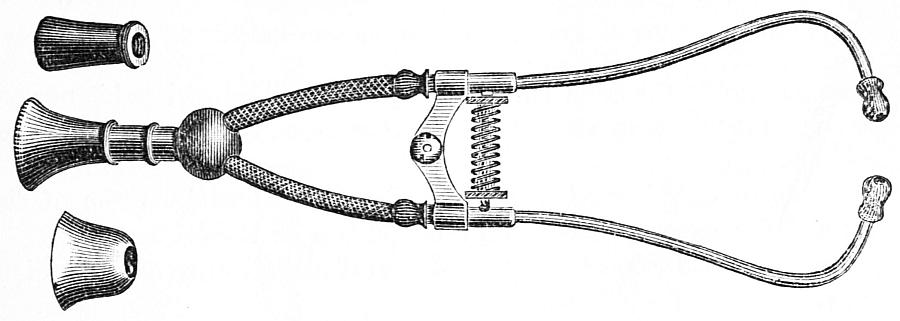Why Doctors Still Need Classic Acoustic Stethoscopes?

Old stethoscope ilustration (via Wikimedia Commons)
An outlasted medical device that can’t be replaced by any other
The stethoscope is an acoustic medical equipment used by physicians to detect internal sounds produced within the body. It generally consists of two tubes connected to earpieces and a small disc-shaped resonator that is placed on the area to be examined. It is commonly used to take a blood pressure reading along with the aid of sphygmomanometer. It is used to detect and study sounds produced by internal organs such as heart and lung for the purpose of diagnosis. It is also used to diagnose arterial and venous blood flow disorders and disorders related to intestines.
It was invented by Rene Theophile Hyacinthe Laennec in France in 1816. It consisted of a wooden tube that operated based upon an acoustic phenomenon. A new, lighter model of stethoscope with improved acoustics was later devised by David Littmann, a Harvard Medical School professor in the early 1960s. Dr. Tarek Loubani introduced an open-source 3D-printed stethoscope in 2015, a latest model that has a more affordable order of magnitude compared to its non-3D-printed counterparts.
Usage of Classic acoustic stethoscopes
Acoustic stethoscope is a two-sided stethoscope invented by the Rappaport and Sprague during the early 20th century. It is the most frequently used type of stethoscope and it uses a phenomenon that transmits sound from the air-filled hollow tubes of chest piece to the auscultator’s ears. The chest piece consists of two sides: bell and a diaphragm. Low frequency sounds are transmitted by the bell, while higher frequency sounds are transmitted by the diaphragm.
Stethoscope as medical armamentarium
Stethoscope represents a traditional symbol of physicians and various other healthcare professionals. In the recent years, healthcare providers are generally seen wearing stethoscopes around their necks in a standard, shawl-like fashion. Older doctors are seen wearing stethoscope models with ear pieces that join at the back of the neck, which projects a notion that they are likely to examine more number of patients.
According to a research study published in 2012, it has been demonstrated that stethoscope has a highest positive impact (placebo effect) and it enhances the trustworthiness of a practitioner compared to other medical devices. However, its use is limited to certain health care specialties such as medicine, emergency medical services and surgical fields. In addition, Healthcare experts agree that stethoscopes provide clues to diseases related to respiratory, cardiovascular and bowel systems.
According to today’s medical literature, the stethoscope’s role draws a critical debate in modern medicine. Does the equipment belong to an old-fashioned doctor’s bag? Can this old medical equipment be replaced by an advanced, new technology? Many research articles about stethoscopes claim that stethoscopes can spread microbes to patients and are sources of nosocomial infections. It bolsters an idea whether the tradition of stethoscope exam increases the risk of causing healthcare-associated infections. As a preventive measure, some hospitals have instructed their healthcare professionals to avoid wearing white coat and long sleeves to prevent hospital infections.
In conclusion, many doctors with stethoscopes agree that patients look with reverence and they are hesitant to give up their stethoscopes. It seems more likely that doctors with stethoscopes tend to win patients trust.
